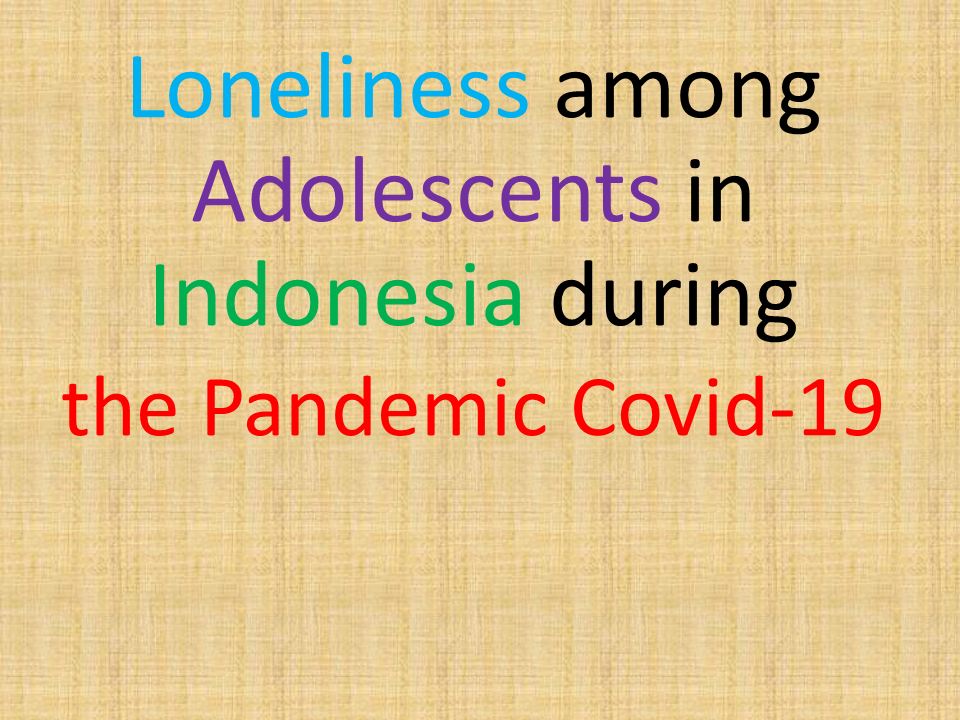Associated Factors of Loneliness Among Adolescents in Indonesia during the Pandemic of Covid-19
DOI:
https://doi.org/10.23917/bik.v17i1.2979Keywords:
Adolescents, Loneliness, Pandemic of Covid-19Abstract
Outbreak of Corona virus disease (Covid) in 2020 affected people’s life, particularly adolescents. Loneliness was one of the problems that adolescents faced during the outbreak of Covid-19. Loneliness could affect adolescents health, both mental and physical health. On the other hands, there were a lot of factors that related to loneliness among adolescents. Therefore, the purpose of this study was to explore the factors associated with loneliness in adolescents in Indonesia during the Covid-19 pandemic. Methodology this study was a cross-sectional study. The respondents in this study were 590 adolescents. This study was using some questionnaires that distributed online by social media. The questionnaire included the Connor Davidson Resilience Scale (CD-RISC)-25, the UCLA loneliness Scale version 3, and demographic characteristics. Hierarchical linear regression was performed to investigate the determinant factors of loneliness among adolescents. Results this current study found that age group of 16-19 YO (β = .117); female adolescents (β = .095); trust in one’s instincts, tolerance to negative affect, and strengthening effects of stress (β = .130); and spiritual influence (β = .094) were associated with increasing loneliness in adolescents. For the positive acceptance of change, and secure relationship (β = -.289); and control (β = -.273) were associated with lower likelihood of having loneliness. Conclusion this current study found that age group of 16-19 YO; female adolescents; trust in one’s instincts, tolerance to negative affect, and strengthening effects of stress; and spiritual influence were associated with increasing loneliness in adolescents. For the positive acceptance of change, and secure relationship; and control were associated with lower likelihood of having loneliness. The current results, particularly the identification of associated factors, should be useful for developing loneliness-prevention program.
Downloads
References
Andriani, L., Febria, C., & Oktavia, R. J. J. o. M. (2021). The Relationship of Family Communication Level With The Sexual Behavior of Adolescent With Disability In The Umbrella Disability Project (UDP) Bukittinggi City. 6(2), 45-52. https://doi.org/10.25077/jom.6.2.45-52.2021
Arimoto, A., & Tadaka, E. (2019). Reliability and validity of Japanese versions of the UCLA Loneliness Scale Version 3 for use among mothers with infants and toddlers: A cross-sectional study. BMC women's health, 19(1), 1-9. https://doi.org/10.1186/s12905-019-0792-4
Barreto, M., Victor, C., Hammond, C., Eccles, A., Richins, M. T., Qualter, P. J. P., & Differences, I. (2021). Loneliness around the world: Age, gender, and cultural differences in loneliness. 169, 110066. https://doi.org/10.1016/j.paid.2020.110066
Bokhorst, C. L., Sumter, S. R., & Westenberg, P. M. J. S. d. (2010). Social support from parents, friends, classmates, and teachers in children and adolescents aged 9 to 18 years: Who is perceived as most supportive? , 19(2), 417-426. https://doi.org/10.1111/j.1467-9507.2009.00540.x
Bolzetta, F., Veronese, N., Stubbs, B., Noale, M., Vaona, A., Demurtas, J., . . . Caruso, M. G. J. N. (2019). The relationship between dietary vitamin K and depressive symptoms in late adulthood: a cross-sectional analysis from a large cohort study. 11(4), 787. https://doi.org/10.3390/nu11040787
Cacioppo, J. T., Hughes, M. E., Waite, L. J., Hawkley, L. C., Thisted, R. A. J. P., & aging. (2006). Loneliness as a specific risk factor for depressive symptoms: cross-sectional and longitudinal analyses. 21(1), 140. DOI: 10.1037/0882-7974.21.1.140
Cénat, J. M., Blais-Rochette, C., Kokou-Kpolou, C. K., Noorishad, P.-G., Mukunzi, J. N., McIntee, S.-E., . . . Labelle, P. R. J. P. r. (2021). Prevalence of symptoms of depression, anxiety, insomnia, posttraumatic stress disorder, and psychological distress among populations affected by the COVID-19 pandemic: A systematic review and meta-analysis. 295, 113599. https://doi.org/10.1016/j.psychres.2020.113599
Connor, K. M., & Davidson, J. R. (2003). Development of a new resilience scale: The Connor‐Davidson resilience scale (CD‐RISC). Depression and anxiety, 18(2), 76-82. doi:10.1002/da.10113
Cooper, K., Hards, E., Moltrecht, B., Reynolds, S., Shum, A., McElroy, E., & Loades, M. J. J. o. A. D. (2021). Loneliness, social relationships, and mental health in adolescents during the COVID-19 pandemic. 289, 98-104. https://doi.org/10.1016/j.jad.2021.04.016
Cost, K. T., Crosbie, J., Anagnostou, E., Birken, C. S., Charach, A., Monga, S., . . . psychiatry, a. (2022). Mostly worse, occasionally better: impact of COVID-19 pandemic on the mental health of Canadian children and adolescents. 31(4), 671-684. https://doi.org/10.1007/s00787-021-01744-3
de Jong-Gierveld, J. (2021). Loneliness and the degree of intimacy in interpersonal relationships. In The emerging field of personal relationships (pp. 241-249): Routledge.
Devi, H. M., Purborini, N., & Chang, H.-J. (2021). Mediating effect of resilience on association among stress, depression, and anxiety in Indonesian nursing students. Journal of Professional Nursing. https://doi.org/10.1016/j.profnurs.2021.04.004
Domènech-Abella, J., Lara, E., Rubio-Valera, M., Olaya, B., Moneta, M. V., Rico-Uribe, L. A., . . . epidemiology, p. (2017). Loneliness and depression in the elderly: the role of social network. 52(4), 381-390. https://doi.org/10.1007/s00127-017-1339-3
Ebesutani, C., Drescher, C. F., Reise, S. P., Heiden, L., Hight, T. L., Damon, J. D., & Young, J. J. J. o. P. A. (2012). The importance of modeling method effects: Resolving the (uni) dimensionality of the loneliness questionnaire. 94(2), 186-195. https://doi.org/10.1080/00223891.2011.627967
Falguera, C. C., De los Santos, J. A. A., Galabay, J. R., Firmo, C. N., Tsaras, K., Rosales, R. A., . . . Labrague, L. J. J. I. j. o. n. p. (2021). Relationship between nurse practice environment and work outcomes: A survey study in the Philippines. 27(1), e12873. https://doi.org/10.1111/ijn.12873
Fu Keung Wong, D., & Song, H. X. J. I. J. o. S. P. (2008). The resilience of migrant workers in Shanghai China: the roles of migration stress and meaning of migration. 54(2), 131-143. https://doi.org/10.1177/0020764007083877
Garcia de Avila, M. A., Hamamoto Filho, P. T., Jacob, F. L. d. S., Alcantara, L. R. S., Berghammer, M., Jenholt Nolbris, M., . . . health, p. (2020). Children’s anxiety and factors related to the COVID-19 pandemic: An exploratory study using the children’s anxiety questionnaire and the numerical rating scale. 17(16), 5757. https://doi.org/10.3390/ijerph17165757
Goossens, L., Klimstra, T., Luyckx, K., Vanhalst, J., & Teppers, E. J. P. B. (2014). Reliability and validity of the Roberts UCLA Loneliness Scale (RULS-8) with Dutch-speaking adolescents in Belgium. 54(1). DOI: http://dx.doi.org/10.5334/pb.ae
Hensley, B., Martin, P., Margrett, J. A., MacDonald, M., Siegler, I. C., Poon, L. W., & psychology, T. G. C. S. J. T. J. o. (2012). Life events and personality predicting loneliness among centenarians: Findings from the Georgia Centenarian Study. 146(1-2), 173-188. https://doi.org/10.1080/00223980.2011.613874
Holmes, E. A., O'Connor, R. C., Perry, V. H., Tracey, I., Wessely, S., Arseneault, L., . . . Everall, I. J. T. L. P. (2020). Multidisciplinary research priorities for the COVID-19 pandemic: a call for action for mental health science. 7(6), 547-560. https://doi.org/10.1016/S2215-0366(20)30168-1
Houghton, S., Kyron, M., Hunter, S. C., Lawrence, D., Hattie, J., Carroll, A., & Zadow, C. J. J. o. a. (2022). Adolescents' longitudinal trajectories of mental health and loneliness: The impact of COVID‐19 school closures. 94(2), 191-205. https://doi.org/10.1002/jad.12017
Kokou-Kpolou, C. K., Megalakaki, O., Laimou, D., & Kousouri, M. J. P. r. (2020). Insomnia during COVID-19 pandemic and lockdown: Prevalence, severity, and associated risk factors in French population. 290, 113128. https://doi.org/10.1016/j.psychres.2020.113128
Kwiatkowska, M. M., Rogoza, R., & Kwiatkowska, K. (2018). Analysis of the psychometric properties of the Revised UCLA Loneliness Scale in the Polish adolescent sample. Current Issues in Personality Psychology, 5, 1-7. doi:10.5114/cipp.2017.69681
Labrague, L. J., De los Santos, J. A. A., & Falguera, C. (2021). Social and emotional loneliness among college students during the COVID-19 pandemic: The predictive role of coping behaviours, social support, and personal resilience. Retrieved from https://doi.org/10.21203/rs.3.rs-93878/v2
Lahiri, A., Jha, S. S., Acharya, R., Dey, A., & Chakraborty, A. J. P. o. (2021). Has loneliness and poor resilient coping influenced the magnitude of psychological distress among apparently healthy Indian adults during the lockdown? Evidence from a rapid online nation-wide cross-sectional survey. 16(1), e0245509. https://doi.org/10.1371/journal.pone.0245509
Listyandini, R., & Akmal, S. (2015). Hubungan antara kekuatan karakter dan resiliensi pada mahasiswaProsiding Temu Ilmiah Nasional Psikologi
Luhmann, M., & Hawkley, L. C. J. D. p. (2016). Age differences in loneliness from late adolescence to oldest old age. 52(6), 943. https://psycnet.apa.org/doi/10.1037/dev0000117
Magis‐Weinberg, L., Gys, C. L., Berger, E. L., Domoff, S. E., & Dahl, R. E. J. J. o. R. o. A. (2021). Positive and negative online experiences and loneliness in Peruvian adolescents during the COVID‐19 lockdown. 31(3), 717-733. https://doi.org/10.1111/jora.12666
Majumdar, P., Biswas, A., & Sahu, S. J. C. i. (2020). COVID-19 pandemic and lockdown: cause of sleep disruption, depression, somatic pain, and increased screen exposure of office workers and students of India. 37(8), 1191-1200. https://doi.org/10.1080/07420528.2020.1786107
Marchini, S., Zaurino, E., Bouziotis, J., Brondino, N., Delvenne, V., & Delhaye, M. J. J. o. c. p. (2021). Study of resilience and loneliness in youth (18–25 years old) during the COVID‐19 pandemic lockdown measures. 49(2), 468-480. https://doi.org/10.1002/jcop.22473
Nicolaisen, M., Thorsen, K. J. T. I. J. o. A., & Development, H. (2014). Who are lonely? Loneliness in different age groups (18–81 years old), using two measures of loneliness. 78(3), 229-257. https://doi.org/10.2190/AG.78.3.b
Panayiotou, G., Panteli, M., Theodorou, M. J. P., Community, & Health. (2016). Predictors of loneliness in a sample of college men and women in cyprus: The role of anxiety and social skills. 5(1). https://doi.org/10.23668/psycharchives.2288
Peng, M., Mo, B., Liu, Y., Xu, M., Song, X., Liu, L., . . . Yu, Z. J. J. o. a. d. (2020). Prevalence, risk factors and clinical correlates of depression in quarantined population during the COVID-19 outbreak. 275, 119-124. https://doi.org/10.1016/j.jad.2020.06.035
Permata, D. C., & Listiyandini, R. A. (2015). Peranan pola asuh orang tua dalam memprediksi resiliensi mahasiswa tahun pertama yang merantau di JakartaProsiding PESAT (Vol. 6).
Russell, D. W. (1996). UCLA Loneliness Scale (Version 3): Reliability, validity, and factor structure. Journal of personality assessment, 66(1), 20-40. https://doi.org/10.1207/s15327752jpa6601_2
Shabrina, C. H., & Nursasi, A. Y. J. E. c. (2018). Correlation between parent-adolescent communication and adolescents’ premarital sex risk. 28, 51-54. https://doi.org/10.1016/S1130-8621(18)30036-6
Solmi, M., Veronese, N., Galvano, D., Favaro, A., Ostinelli, E. G., Noventa, V., . . . Shin, J. I. J. J. o. a. d. (2020). Factors associated with loneliness: an umbrella review of observational studies. 271, 131-138. https://doi.org/10.1016/j.jad.2020.03.075
Thomas, L. J., & Revell, S. H. J. N. e. t. (2016). Resilience in nursing students: An integrative review. 36, 457-462. https://doi.org/10.1016/j.nedt.2015.10.016
Valtorta, N. K., Kanaan, M., Gilbody, S., Ronzi, S., & Hanratty, B. J. H. (2016). Loneliness and social isolation as risk factors for coronary heart disease and stroke: systematic review and meta-analysis of longitudinal observational studies. 102(13), 1009-1016. DOI : 10.1136/heartjnl-2015-308790
Wang, C., Pan, R., Wan, X., Tan, Y., Xu, L., Ho, C. S., . . . health, p. (2020). Immediate psychological responses and associated factors during the initial stage of the 2019 coronavirus disease (COVID-19) epidemic among the general population in China. 17(5), 1729. https://doi.org/10.3390/ijerph17051729
Wu, Z., Penning, M. J. A., & Society. (2015). Immigration and loneliness in later life. 35(1), 64-95. https://doi.org/10.1017/S0144686X13000470
Zulu, N. T. J. S. A. J. o. P. (2019). Resilience in Black women who do not have fathers: A qualitative inquiry. 49(2), 219-228. https://doi.org/10.1177/0081246318782187

Downloads
Submitted
Accepted
Published
How to Cite
Issue
Section
License
Copyright (c) 2024 Santa Maria Panggaribuan, Loritta Yemina, Sri Hunun Widiastuti, Nurul Purborini, Casman Casman

This work is licensed under a Creative Commons Attribution 4.0 International License.


















